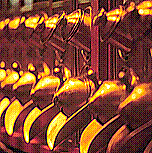 Once upon a time, drinking a cup of coffee was a simple proposition; you drank it black, with milk, and/or
with sugar. Those days are gone.
Once upon a time, drinking a cup of coffee was a simple proposition; you drank it black, with milk, and/or
with sugar. Those days are gone.
 Once upon a time, drinking a cup of coffee was a simple proposition; you drank it black, with milk, and/or
with sugar. Those days are gone.
Once upon a time, drinking a cup of coffee was a simple proposition; you drank it black, with milk, and/or
with sugar. Those days are gone.
Only the humblest of eateries would dare serve coffee in such form these days. Those worth their salt at least offer espresso and cappuccino. Coffee bars take this several steps further, turning a "cup of Joe" into as many variations as there are places where the coffee bean is cultivated.
What follows is a Baedeker, courtesy of several of Princeton's coffee purveyors and printed resources.
Of the two types of coffee plants used in commercial coffee production, arabica is preferred as the basis for specialty coffees. Just as wines are judged by different characteristics, coffee beans grown in different locations around the globe are known for different qualities of body, acidity and flavor.
A handy booklet prepared by the folks at Bucks County Coffee Company describes these three qualities in more detail. Body, for example, refers to the light, medium or full feeling a coffee taste leaves in one's mouth. Those who like their coffee black, the booklet suggests, may want a coffee with a lighter body than those who douse their brew with milk.
An acidity rating describes how the coffee affects the palate, either as sharp and lively or as mellow and soft. Flavor - the most important quality - is described with terms such as spicy, winey and bold.
These qualities provide a vocabulary for the daunting number of coffee combinations from which one may choose, some grown as close to home as Mexico, others as far as Indonesia. As with wine or chocolate, there are some coffees that are spoken of in reverential terms. These include Hawaiian Kona and Jamaica Blue Mountain, both grown in small amounts compared to Colombia Supremo, and so all the more desirable.
Most people who spend the $16 or so a pound Hawaiian Kona or Jamaica Blue Mountain can command want their brew undiluted with any other beans. When it comes to other beans, however, blends can match the desirable qualities of one type with the highlights of another, customizing a coffee taste. The house blend at Bucks County, for example, combines Kenya "AA" and a French roast with a Brazil Bandeirante for what the micro-roasters call a balanced and full-bodied coffee.
So what's a French roast? Coffee beans can be roasted light or dark, depending on the flavor desired. In general, lighter roasts usually mean a sharper, tangy flavor while darker ones produce a deeper, mellower one. French, Vienna and espresso roasts are dark roasts, bringing the beans to the point of charring, and it is this flavor that dominates the taste of the beans.
One last drop: flavored coffees such as hazelnut or chocolate raspberry are sprayed with oils to add the accent desired.
Sipping coffee in a cafe - no matter where the beans came from - provokes its own images. Hanging out at a cafe is nothing new: the first coffee shop opened in Constantinople in 1475. It took until 1652 for England to catch up, but then coffeehouses became all the rage, and were nicknamed "penny universities" - a cup cost a penny and you could get an education listening to all the conversations going on.
Legend says we have Captain John Smith to thank for bringing coffee to our shores but the Boston Tea Party made drinking it a patriotic act. Maxwell House, named for the blend served in a Nashville, Tenn. hotel, debuted in 1886, but it was Hills Brothers that first packed roasted coffee in vacuum tins, circa 1900. By 1940, the United States was importing 70 percent of the world's coffee crop.
But back to that image of coffeehouses as places of intellectual repartee and political ferment, a kind of public salon, a place to gather and hash out the ideas of the moment as well as get a jolt of caffeine. Prior to the current caffeine rush, the 1950s offered the most recent canonization of coffee. You could stop anywhere in America, just about, and get a cup of coffee. With that cup you were part of the common coffee-klatch. Coffeehouses reemerged with the beat generation, offering a place to meet and share the current artistic and political scene, and became part of the West Coast hipness of the 1960s.
Starbucks opened its first store in Seattle's Pike Place Market in 1971, re-introducing the idea of fresh roasted whole bean coffee. The current coffee bars take the excitement Starbucks ignited over whole bean coffee, the remembrance of visits to European sidewalk cafes and the nostalgia of coffeehouses as places to see and be seen and blends them into the newest trend.
 Return To Princeton Patron Magazine
Return To Princeton Patron Magazine